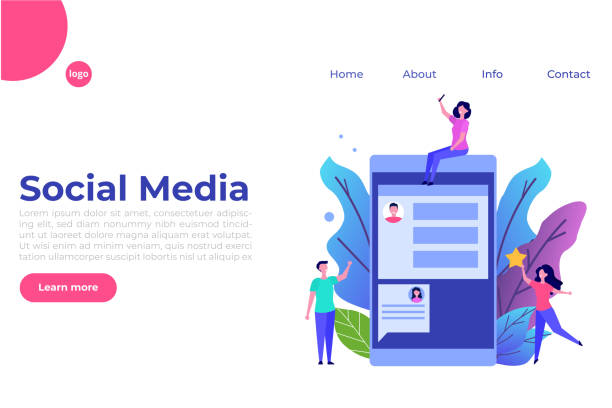Introduction to the Importance of Secure Website Design

In today’s digital world, where reliance on the internet grows daily, secure website design is no longer an option but an undeniable necessity.
With the increasing number of cyber threats and the complexity of attacks, web security has become one of the most important concerns for businesses and users.
#web_security and #data_protection are two main pillars for building a reliable online experience.
The primary goal of implementing security principles in web design is to protect sensitive user data, maintain website integrity, and ensure continuous access to services.
This includes not only preventing unauthorized access but also defending against code injection attacks, privacy breaches, and denial-of-service attacks.
Investing in secure website design not only prevents financial and reputational losses but also significantly increases user trust and acts as a competitive advantage.
It is a comprehensive and multi-layered approach that encompasses everything from initial coding to website deployment and maintenance.
Understanding existing threats and applying best security practices is crucial for any organization planning an active online presence.
Are you tired of your online store not generating as much revenue as it could? Rasaweb, specializing in professional e-commerce website design, solves this problem once and for all!
✅ Increase sales and revenue
✅ High loading speed and unparalleled user experience
⚡ Get free e-commerce website design consultation
Common Web Security Threats and Countermeasures

Recognizing cyber threats is the first step in secure website design.
Websites are constantly targeted by various attacks, each with its own objective and method.
#cyber_threats such as #XSS_attacks (Cross-Site Scripting), where attackers inject malicious code into websites to steal user information, or #CSRF_attacks (Cross-Site Request Forgery), which trick users into performing unwanted actions on trusted websites, are among the most common.
#DDoS attacks (Distributed Denial of Service) also lead to website downtime by sending a huge volume of traffic to the server.
To counter XSS, it is essential to use strict input validation and output encoding for user inputs.
For CSRF, anti-CSRF tokens can be used to ensure that requests are authorized and self-initiated by the user.
Against DDoS attacks, using cloud protection services and Web Application Firewalls (WAF) can be effective.
Furthermore, Brute Force attacks to guess passwords, SQL Injection attacks to access databases, and File Inclusion attacks to execute malicious code on the server, are other serious threats.
Each of these threats requires specific defensive strategies that must be comprehensively considered in the secure website design process.
A proactive and multi-layered approach is the key to success in dealing with these challenges.
The Role of SSL/TLS and Security Protocols in Secure Website Design

One of the main pillars in secure website design is the use of encryption protocols such as #SSL (Secure Sockets Layer) and its newer, more secure version, #TLS (Transport Layer Security).
These protocols ensure that communication between the user and the web server is encrypted and secure.
When a website uses HTTPS instead of HTTP, it means that data is encrypted before being sent over the internet, preventing unauthorized access by attackers.
This is especially critical for websites that collect sensitive information such as credit card numbers, passwords, or personal data.
SSL/TLS certificates also verify the website’s identity, assuring users that they are communicating with the genuine website and not a fake or phishing site.
Browsers mark websites without HTTPS as insecure, which can harm the website’s credibility and SEO ranking.
Using HTTPS not only increases security but also plays an important role in improving the website’s search engine ranking.
Below, a comparative table between HTTP and HTTPS features is presented, clearly demonstrating the key role of SSL/TLS in secure website design.
| Feature | HTTP | HTTPS |
|---|---|---|
| Encryption | Data is sent in plain text. | Data is encrypted (by SSL/TLS). |
| Security | Vulnerable to eavesdropping and data tampering attacks. | High security, protection against eavesdropping and tampering. |
| Authentication | Server identity is not verified. | Server identity is verified by SSL/TLS certificate. |
| SEO Ranking | Negative impact on SEO ranking. | Positive impact on SEO ranking (Google prefers HTTPS websites). |
| User Trust | Reduced trust due to “insecure” warning. | Increased trust due to green lock icon in the browser. |
Database Security and Preventing SQL Injection Attacks

The database is the heart of any website, containing critical information, and therefore, its security is of paramount importance.
#database_security is a fundamental component of secure website design.
One of the most dangerous and common attacks against databases is #SQL_Injection.
In this attack, the attacker injects malicious SQL code into website inputs (such as search or login forms), attempting to manipulate the database query structure and access or even delete confidential information.
To prevent these types of attacks, using Prepared Statements (or parameterizing queries) is a highly effective solution.
This method ensures that user inputs are processed as data, not as part of SQL commands.
Furthermore, strict input validation on both the server and client sides is essential to ensure data correctness and proper formatting.
Restricting user access to the database and granting the Principle of Least Privilege, encrypting sensitive information stored in the database, and regularly updating the Database Management System (DBMS) are other critical measures.
Additionally, continuous monitoring of database logs to identify suspicious activities can help in early detection of attacks.
Implementing these measures creates a strong defensive layer against SQL Injection attacks and other database threats, enhancing the robustness of secure website design.
Are you frustrated by the low conversion rate of your online store?
Rasaweb, with professional e-commerce website design, is your definitive solution!
✅ Increase your sales and revenue
✅ Unparalleled user experience for your customers
⚡ Get your free consultation now!
The Importance of Continuous Updates and Patch Management

One of the often-overlooked but vital aspects of maintaining website security is regular updates and #patch_management.
As technologies advance, new vulnerabilities are discovered that can be exploited by attackers.
#security_patches and software updates released by developers are typically designed to address these vulnerabilities and improve security performance.
Neglecting these updates means leaving the website open to known attacks.
This principle applies not only to Content Management Systems (CMS) like WordPress or Joomla but also to plugins, themes, programming libraries, and even the server’s operating system and database software.
Developers should have a regular schedule for checking and applying updates.
Before applying updates in a production environment, testing them in a simulated environment (staging environment) is essential to ensure no disruptions are caused.
Automating the update process as much as possible can help reduce human error and ensure systems are continuously up-to-date.
Patch management is an important part of a comprehensive cybersecurity strategy that ultimately contributes significantly to maintaining website integrity and availability.
A website that is continuously updated is less exposed to cyberattacks, and this is one of the key elements in a comprehensive secure website design approach.
Strong Authentication and Access Management

Authentication and access management systems are the backbone of #user_security and #access_protection for any website.
Secure website design requires the implementation of strong mechanisms to verify user identity and control their access to various resources.
Weak passwords are one of the most common vulnerabilities.
Requiring users to use complex passwords (including uppercase and lowercase letters, numbers, and special characters) and changing them periodically is the first step.
Implementing #multi_factor_authentication (MFA) adds a powerful security layer; meaning, in addition to a password, the user must provide a second method of identity verification (such as a code sent to a mobile phone or a fingerprint).
This significantly reduces the risk of Brute Force and phishing attacks.
In addition to authentication, #access_management plays a critical role.
The “Principle of Least Privilege” states that every user or system should be limited to the minimum access necessary to perform its tasks.
This means that administrators must carefully define user roles and assign the necessary permissions to each role.
For example, a regular user should not have access to administrative settings.
Monitoring user activities and logins is also crucial for identifying suspicious patterns and unauthorized attempts.
These measures together provide a secure and controlled environment for users and data, forming an integral part of secure website design.
Web Application Firewalls (WAF) and Intrusion Detection Systems

To strengthen website defense layers, the use of specialized security tools such as #web_application_firewalls (#WAF) and #intrusion_detection_systems (IDS) or #intrusion_prevention_systems (IPS) is essential.
These tools play a critical role in secure website design.
A WAF sits between the website and the internet, analyzing incoming traffic to identify and block common attacks like SQL Injection, XSS, and Brute Force.
A WAF can filter malicious traffic based on predefined rules or artificial intelligence, preventing it from reaching the web server.
This tool acts as a protective shield at the application layer.
In contrast, an IDS monitors network traffic and alerts when suspicious activities or known attack patterns are identified.
An IPS goes a step further and, in addition to alerting, actively attempts to block attacks.
Both systems are designed for continuous monitoring and rapid response to threats.
Combining WAF with IDS/IPS creates a multi-layered defense strategy that can protect the website against a wide range of attacks.
The correct selection and implementation of these tools, along with their precise configuration, are crucial for maximizing their security capabilities.
These tools not only prevent attacks but also provide valuable data about attack attempts and malicious traffic patterns that can be used to further improve website security.
Below is a table of security tools and their applications:
| Tool Name | Description | Main Application in Security |
|---|---|---|
| Web Application Firewall (WAF) | A firewall that filters and monitors HTTP/S traffic. | Protection against Layer 7 attacks (e.g., SQL Injection, XSS). |
| Intrusion Detection System (IDS) | Monitors network traffic to identify malicious activities. | Identifies attack patterns and alerts administrators. |
| Intrusion Prevention System (IPS) | In addition to detection, actively attempts to block attacks. | Active prevention of network and system intrusions. |
| Vulnerability Scanner | A tool for automatically finding security weaknesses in systems and applications. | Identifies vulnerabilities before attackers do. |
| Password Manager | Software for storing and generating complex and unique passwords. | Strengthens password policies and reduces the risk of Brute Force attacks. |
Penetration Testing and Vulnerability Assessment

After implementing security measures, how can we ensure their effectiveness? #Penetration_Testing and #Vulnerability_Assessment are two critical methods for assessing the website’s defensive strength and identifying weaknesses before attackers discover them.
In the process of #secure_website_design, these stages take on an analytical and offensive aspect.
Vulnerability assessment involves using automated and manual tools to scan systems and applications for known vulnerabilities.
This process provides a list of potential weaknesses that need to be addressed.
On the other hand, penetration testing is a controlled simulation of a real attack, performed by security professionals (known as white hat hackers).
The goal of penetration testing is not only to find vulnerabilities but also to investigate how they can be exploited and to evaluate the potential impact of the attack.
These tests can include network tests, web applications, and even social engineering.
The results of these tests provide comprehensive reports that include details of vulnerabilities, exploitation methods, and recommendations for remediation.
Regularly conducting these tests, especially after any major changes to the website or system, helps organizations continuously improve their security posture and prevent serious attacks.
This proactive approach is an integral part of the comprehensive secure website design process.
How much does losing business leads due to an unprofessional website cost you? Solve this problem forever with professional corporate website design by Rasaweb!
✅ Increase credibility and trust of potential customers
✅ Easier attraction of new business leads
⚡ Get your free consultation now!
Security Incident Response and Data Recovery

Even with the best security measures in secure website design, the probability of security incidents never reaches zero.
Therefore, having a strong #security_incident_response_plan and #data_recovery is crucial.
#incident_management refers to a set of procedures and processes for identifying, containing, eradicating, recovering, and analyzing after a security incident occurs.
An effective plan must include specific steps for security team members, responsibilities, required tools, and communication protocols.
The main goal is to minimize damage as much as possible and quickly restore operations to normal.
This includes rapid detection of security breaches, cutting off attacker access, repairing damaged systems, and analyzing the root cause to prevent its recurrence.
Alongside this, comprehensive #backup and data recovery strategies are essential.
Regular and automated backups of all website data, including databases, files, and configurations, should be performed in multiple secure locations (such as cloud storage or offline servers).
Periodic testing of the data recovery process is also vital to ensure the ability to return to normal after a disaster (whether a cyberattack, hardware failure, or natural disaster).
Having a specialized team or external consultant to assist during incidents can help speed up and make the response more efficient.
This preparedness is the last line of defense against attacks and ensures that even in the event of a breach, its impact on the business is minimized, and this is a critical aspect of secure website design.
The Future of Secure Website Design and Upcoming Challenges

With continuous advancements in technology, the landscape of #web_security and #cyber_challenges is also evolving.
Secure website design in the future requires new approaches and adaptation to emerging threats.
The emergence of Artificial Intelligence (AI) and Machine Learning (ML) not only offers new tools for cybersecurity but attackers also use them to make their attacks smarter.
This increases the need for adaptive and predictive defense systems.
The question arises: can we achieve a level of security where we are never hacked? This is a #thought_provoking_content, and the answer is likely “no”; security is an ongoing process, not a final destination.
Security in the Internet of Things (IoT) and connected devices creates a new challenge for web developers, as these devices can be new entry points for attacks.
Also, concepts like #Zero_Trust_architecture, which assumes that no user or device, whether inside or outside the network, is trustworthy unless their identity and permissions are continuously verified, are becoming prevalent.
Blockchain and Distributed Ledger Technologies (DLT) also have the potential to create decentralized and immutable security solutions that can be effective in securing data and transactions.
#secure_website_design professionals must constantly learn and adapt to these changes to resist a new wave of threats and ensure the stability and security of websites.
The future of web security is bright, but the challenges will be equally vast and complex.
Frequently Asked Questions
| Row | Question | Answer |
|---|---|---|
| 1 | What is secure website design? | Secure website design is a process in which websites are built with security measures in mind from the initial development stages to be protected against cyberattacks, unauthorized access, and data loss. |
| 2 | Why is secure website design important? | Website security is crucial for maintaining user trust, protecting sensitive information (personal and financial), preventing damage to brand reputation, and complying with privacy and security regulations (such as GDPR). A security breach can lead to financial and legal damages. |
| 3 | What are the most common cyberattacks a website faces? | Some of the most common attacks include SQL Injection, Cross-Site Scripting (XSS), Distributed Denial of Service (DDoS), Brute Force, and Credential Stuffing attacks. |
| 4 | What is SQL Injection and how to prevent it? | SQL Injection is an attack where an attacker injects malicious SQL code into website inputs to manipulate the database or extract information. To prevent it, one should use Prepared Statements/Parameterized Queries, ORM (Object-Relational Mapping), and strict input validation. |
| 5 | What is Cross-Site Scripting (XSS)? | XSS is an attack where an attacker injects malicious scripts (usually JavaScript) into web pages that are executed by other users’ browsers. This can lead to cookie theft, session information theft, or changes in the website’s appearance. |
| 6 | How can Brute Force attacks on login pages be prevented? | To prevent Brute Force, CAPTCHA, limiting the number of failed login attempts (Account Lockout), Two-Factor Authentication (2FA), and using complex and long passwords should be implemented. |
| 7 | What is the role of HTTPS in website security? | HTTPS encrypts communication between the user’s browser and the website server using SSL/TLS. This prevents eavesdropping, tampering, or forging of information during transmission and increases user trust. |
| 8 | What is the importance of Input Validation in security? | Input validation is the process of checking and sanitizing data entered by the user. This prevents the injection of malicious code, XSS attacks, SQL Injection, and other vulnerabilities, ensuring that the data conforms to the expected format. |
| 9 | Why is regular updating of website systems and software necessary? | Regular updates of the operating system, CMS (like WordPress), plugins, themes, and libraries used fix known security vulnerabilities. Hackers often exploit weaknesses in outdated software to infiltrate. |
| 10 | What role does regular backup play in secure website design? | Regular and tested backups of website data (database and files) are a critical layer of defense against data loss due to cyberattacks, human error, or hardware failure. This enables quick website recovery in the event of a disaster. |
And other services of Rasaweb Advertising Agency in the field of advertising
Smart Link Building: Designed for businesses seeking online growth through precise audience targeting.
Smart Custom Software: An innovative platform to improve customer acquisition with Google ad management.
Smart Digital Advertising: Revolutionize digital branding with precise audience targeting.
Smart Sales Automation: A fast and efficient solution for campaign management focusing on marketing automation.
Smart UI/UX: An effective tool for digital branding by optimizing key pages.
And over hundreds of other services in the field of internet advertising, advertising consultation, and organizational solutions
Internet Advertising | Advertising Strategy | Sponsored Articles
Resources
Principles of Secure Website Design
Why is SSL essential for your site?
Solutions for Protecting User Data on Websites
Preventing Common Website Attacks
Are you ready to transform your business in the digital world? Rasaweb Digital Marketing Agency, with expertise in SEO, online advertising, and user-friendly website design, is your reliable partner on the path to growth and success.
📍 Tehran, Mirdamad Street, next to Bank Markazi, Kazeroun Jonoubi Alley, Ramin Alley, No. 6

